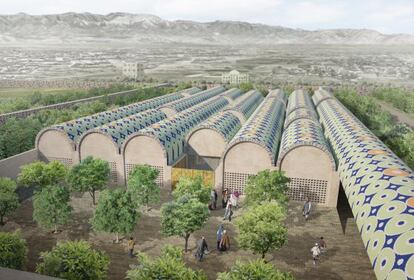A future home for Afghan art
Spanish team wins competition to design the national museum in Kabul

The Barcelona-based architect studio AV62 will build the National Museum of Afghanistan in Kabul after winning a public competition for ideas. This is the second time that the award-winning studio gets to build in an Asian country: AV62 also won a contest to rebuild the neighborhood of Adhamiya, in Baghdad. Another Spanish team, Tuñón y Mansilla, ranked second out of the 70 projects from 43 countries entered in the competition, which was organized by the Afghan Culture Ministry and the US Embassy in Kabul.
The contest rules required experience in museum-building and past work in Muslim countries and conflict situations. AV62 has all that, even though neither one of its members have yet been to the Afghan capital. In fact, studio members Victoria Garriga and Toño Foraster are busy preparing a trip to Baghdad to accept the award for their Adhamiya project, which appears to be mired in red tape (a common occurrence in all Iraqi public projects) now that the mayor has resigned.
It does not seem, however, that the same is going to happen in Kabul, says Foraster, since both local authorities and Washington are very interested in seeing the museum completed as soon as possible.
There is more than one peculiarity to the project. The museum aims to establish a certain history of Afghanistan, a narrative thread that Afghans can identify with, or at least use to get a sense of the nation's multiple histories. Due to decades of war, all artwork has been lost or dispersed - when it has not been downright destroyed, like the giant Buddhas of Bamiyan - or else it is not even catalogued. This means that museum designers do not know how large it should be, what the collection will look like or how it will be distributed. Considering these limitations, the project was conceived as a series of "deformable, flexible spaces that can adapt to the times."
Their inspiration, admits Garriga, was ultimately the modular spaces created within the famous Spanish cathedral/mosque known as La Mezquita de Córdoba, which is one of the icons of the Islamic world. This type of construction can be extended or reduced according to the needs of the moment.
But defining Afghan history for the museum will create a major debate, and not an academic one but largely a political and social one, given the variety of cultures that settled down in this area at one point or another. Also to be considered are the esthetic canons of Islamic society.

"Clearly, the problem of representing human figures will crop up," says Foraster. "What will they do with the sculptures of Bagram, of Hindu origin, which include women with large, bare breasts? What will happen with the inevitable reference to the Buddhas of Bamiyan? Maybe they will want to award greater importance to the Mughal period, when Islamization took place, and skip over the rest..."
The model created by Foraster and Garriga does not impose a particular order in the way rooms must be viewed. Instead, the key factor when it came to designing the museum was security. Violence remains very much present in Kabul, and terrorist activity requires that the entire museum complex be surrounded by a security wall. This "closed universe behind walls" allowed the architects to tie in their project with the tradition of the Muslim home with an inner patio - "a perimeter that allows one to confine nature and life in order to preserve it and protect it from a hostile environment, in the tradition of the desert people in love with mathematics and geometry."
Another rule of the contest was that construction should at least partly employ local workers, which meant incorporating traditional building techniques.
Regarding the likelihood that the museum will finally be built, or indeed the Iraqi neighborhood of Adhamiya be renewed, Garriga and Foraster display a mixture of realism and determination: "It's not a question of money, but about moving from the idea phase to the building phase. It's the authorities who must now carry out the definitive project, which might take elements from other contestants. But the main problem that Spanish architects have detected is that authorities do not understand that you need an in-between phase between the project and construction, when the production process is established," they explain. Convincing them of all that will be their goal on their trips to Baghdad and Kabul.
Tu suscripción se está usando en otro dispositivo
¿Quieres añadir otro usuario a tu suscripción?
Si continúas leyendo en este dispositivo, no se podrá leer en el otro.
FlechaTu suscripción se está usando en otro dispositivo y solo puedes acceder a EL PAÍS desde un dispositivo a la vez.
Si quieres compartir tu cuenta, cambia tu suscripción a la modalidad Premium, así podrás añadir otro usuario. Cada uno accederá con su propia cuenta de email, lo que os permitirá personalizar vuestra experiencia en EL PAÍS.
¿Tienes una suscripción de empresa? Accede aquí para contratar más cuentas.
En el caso de no saber quién está usando tu cuenta, te recomendamos cambiar tu contraseña aquí.
Si decides continuar compartiendo tu cuenta, este mensaje se mostrará en tu dispositivo y en el de la otra persona que está usando tu cuenta de forma indefinida, afectando a tu experiencia de lectura. Puedes consultar aquí los términos y condiciones de la suscripción digital.








































